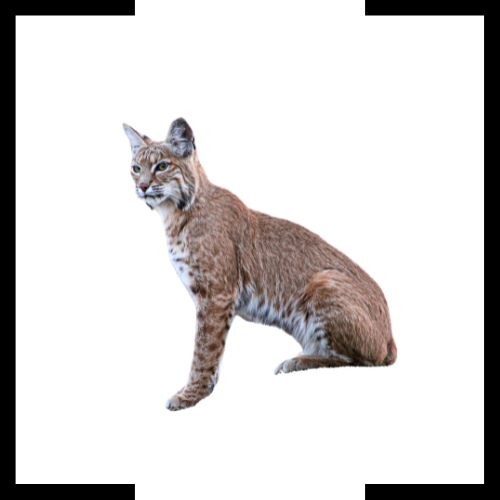As humans continue to expand urban areas, bobcats are becoming a relatively common sight in Idaho towns. In some areas, you could even say they are the new neighborhood cat. Due to their carnivorous diet and love of feasting on small wild animals, they can sometimes serve as excellent all-natural pest control. Researchers have found dead specimens with as many as 23 rats in their stomachs.
In addition to rodents, they like to eat other small mammals and birds. As opportunistic predators, a hungry bobcat can eat whatever is available. Their kills are very distinguishable, leaving claw marks on the sides, back, and shoulders of their prey as they go for a single killing bite to the throat. They are also known for climbing trees, where they make a snack out of nesting birds or leap onto unsuspecting deer below. When they have leftovers from larger prey, they can cover it up with whatever foliage or dirt is available to return to later.
Though the shy and reclusive bobcat is rarely a danger to humans, that certainly does not mean you want them roaming around your property. While they do not damage structures, they can cause quite a scare and make you and your family uncomfortable during outdoor activities. On occasion, they may even attack or abduct pets or feast on livestock when starved of natural prey.
Dealing With Idaho Bobcats
In the lower 48 states, they are the most common and widely distributed feline. There are 2 other wild cats in Idaho, the cougar and the Canada Lynx. To the untrained eye, the bobcat and lynx can be mistaken for one another. Do not mistake their solitary nature for cowardice. They are proud and confident creatures that can be brazenly aggressive when protecting their den or feeling threatened. Though they may retreat from a fight, their motivations are annoyance and irritation rather than fear. If one does approach you, be extremely wary and ready to defend yourself by any means necessary. A bobcat that is attempting to engage with you may be rabid and very dangerous.
In urban areas, there have been unfortunate incidences of bobcats climbing backyard fences and attacking pet dogs. Fortunately, pet abductions are considerably rare. As nocturnal hunters, bobcats can be dissuaded by installing bright, motion-sensor lights in your yard or around livestock quarters. They prefer hunting in low-light conditions, waking up several hours before sunset only to go back to sleep around midnight and wake up an hour before dawn.
Most of the time, an exclusion fence is enough to discourage them from entering your property. However, barriers must be over six feet high, extend underground, and be protected on top by an outward-facing wide-angle extension. If exclusionary measures fail to stave them off, they may need to be removed from the area by a professional wildlife removal service. The experts at Agricole Wildlife Solutions are capable of using both exclusion and removal techniques to take care of intruding bobcats. Contact us today to learn more about our nuisance wildlife services.
Frequently Asked Bobcat Questions
Q1. How do bobcats impact local wildlife and domestic animals?
A1. Bobcats are predators by nature, which means their diet primarily consists of other animals. They play a crucial role in controlling the population of prey species, such as rodents and small mammals. However, their hunting habits can sometimes lead to conflicts, especially in areas where human populations encroach on their natural habitats. Bobcats have been known to prey on livestock and poultry, which can lead to financial losses for farmers. Additionally, in areas where their natural prey is scarce, bobcats might target domestic pets as food sources. This predatory behavior is a natural instinct for survival but can cause tension between human and bobcat populations.
Q2. Can bobcats pose a threat to human safety?
A2. Bobcats generally avoid human contact and are not typically considered a significant threat to human safety. However, like any wild animal, they can become aggressive if cornered, threatened, or if they feel their young are in danger. Instances of bobcats attacking humans are extremely rare but can occur, particularly in situations where a bobcat may be sick or rabid. In areas where bobcats are more accustomed to human presence, they may also become bolder, leading to increased sightings and potential for conflicts. It's important for people living in areas inhabited by bobcats to be aware of their behavior and take precautions to avoid close encounters.
Q3. What are the challenges in managing bobcat populations?
A3. Managing bobcat populations presents several challenges, especially as human developments continue to encroach on their natural habitats. Conservation efforts aim to maintain healthy bobcat populations while minimizing negative interactions with humans. However, these efforts are complicated by factors such as habitat loss, changes in prey availability, and climate change. In some regions, bobcats are hunted for their fur or controlled to protect livestock, which can impact their populations. Effective management requires a delicate balance between protecting bobcat populations and addressing the concerns of communities living close to these predators. Strategies include habitat conservation, public education on living alongside bobcats, and, where necessary, controlled management actions to prevent overpopulation or mitigate conflicts.


